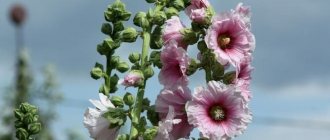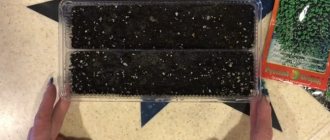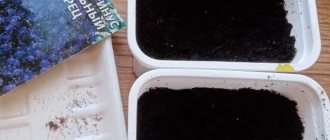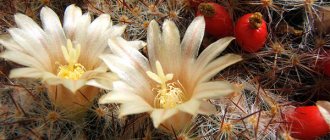Bacopa, also known as sutera, is a member of the plant family. This genus includes more than 100 species, which are aquatic, moisture-loving, succulent rhizomatous perennials. Their homeland is the Canary Islands and South America. In nature, bacopa grows most readily on the swampy shores of various bodies of water in the subtropical and tropical zones of Australia, Africa, Asia and America. It was introduced in 1993 and is grown in temperate climates as an emergent or ampelagic plant.
Brief description of cultivation
- Bloom. Bacopa blooms profusely, over time the flowering weakens, but then intensifies again.
- Landing. Seeds are sown for seedlings in March. Transplant into supporting structures or open ground in mid-May.
- Lighting. Well-lit and shady areas with reliable protection from gusts of wind are suitable.
- The soil. It should be permeable to water and air and rich in humus and nutrients. Soil acidity should be slightly acidic.
- Watering. Water the soil frequently and deeply, and even more during dry periods.
- Fertilization. Bacopa should only be fertilized in spring and summer when it is young. To do this, alternate organic and mineral complex fertilizers.
- Trimming and cutting. To make the bush more lush, shoots are regularly pruned, and if there are shoots that are too long, they should be shortened. Pruning should be done when the bush begins to bloom very profusely and the lower part of the shoots becomes woody.
- Spreading. Seeds and apical cuttings (in January-April).
- Pests. Aphids, whiteflies and spider mites indoors.
- Diseases. Sooty mold or mildew and gray mold.
general information
Bacopa is also called sutera, and is a herbaceous plant with straight or, more often, creeping stems. Some perennial varieties become woody over time. Bacopa shoots are densely covered with small bright leaves, the juice of which smells like citrus. The entire green part may have slight pubescence.
The Bacopa genus is very diverse. It contains true succulents that can easily tolerate drought and store water in their fleshy leaves. And there are moisture-loving species that can grow in water and are even used for landscaping ponds or aquariums.
Photo: yage.ru
Features of ampelous bacopa
Creeping, slender stems, can be erect or drooping, up to 0.6 m in length and width. Linear, small leaf blades are ovate or broadly elliptic, olive green or green, with a serrated edge. When flowering, fragrant flowers are formed, which can be tubular or bell-shaped (depending on the species and variety). Flowers can be large or small, bright or simple, pink, blue, red, violet, white, lilac, blue or violet. The flowering of this plant lasts a very long time and occurs in waves: when the first abundant wave ends, the flowering fades, and after a while the bushes begin to bloom even more luxuriantly. Bacopa has a short lifespan, but can be easily propagated if necessary. This flower can be grown both indoors and outdoors.
Houseplant bacopa-violet “magic of love”: description, photo
There is bacopa violet, which is grown on the windowsill. It is significantly different from its hanging and aquarium relatives. Saintpaulias are a genus of evergreen herbaceous plants discovered in 1892 by Walter von Saint-Paul.
A characteristic feature of these violets is their long petiole. Basal rosettes have a large gap at the base. The leaves are large, dark green, and the peduncles are elongated. The flowers are large, up to 5 cm in diameter. This variety has a special color and shape of the flower - it is densely double, pink-beet color with a white border along the edge.
Small strokes of white or pink are allowed. It blooms profusely and for a long time, up to two months. This is due to the fact that a double flower takes a long time to fully open. Despite the gorgeous flowers, the appearance is spoiled by a spreading rosette with leaves sticking up; outside the flowering period, the violet looks very bare.
In terms of care, the “magic of love” is not particularly whimsical. Like any violets, it loves moderate watering at the root and moderate lighting with diffused rays. When directly exposed to the sun, the green cover begins to deteriorate, and with abundant watering, Saintpaulia can contract various fungal and putrefactive diseases.
Know! The optimal solution for caring for violets is wick watering. It involves placing a small cord in a flower pot. The second end is located in a container with water underneath it.
Growing bacopa from seeds
Sowing
If you don't already have bacopa in your garden, you'll need to grow it from seed. It is not difficult to obtain good seedlings from seeds, especially since high-quality seeds are easily available in specialized stores.
Start sowing seedlings in March. Fill the container with clean peat soil, previously disinfected for 4 hours in the oven (at about 100 degrees). Allow the substrate to cool completely before pouring it into a container. Level the surface of the soil in the pot and distribute the seeds evenly over it. There is no need to cover the top of the seeds, but instead lightly press them into the pre-moistened potting mix. Cover the seedlings with glass (foil) and place them in a well-lit and warm place (at least 20 degrees Celsius). The first shoots may appear in one and a half to two weeks, and 3-4 weeks are enough for complete germination.
Growing seedlings
Caring for bacopa seedlings is relatively simple, but it should be remembered that immediately after the first shoots appear, it is necessary to ensure that the surface of the substrate in the container does not dry out. The surface of the soil around the seedlings should be carefully scarified at regular intervals. The first time the seedlings should be planted after the formation of 3 leaves. Use individual peat pots up to 50mm in diameter. When the seedlings get used to the new place, fertilize them with complex mineral fertilizer, and the concentration of the finished nutrient solution should be half that recommended by the manufacturer (see instructions).
Seedlings grow best at temperatures between 22 and 26 degrees. When growing bacopa plants outdoors, in open ground, it is recommended to transplant them into slightly larger pots after a while. To give the seedlings greater stability, it is recommended to immerse the shoots in the substrate at one node. 7 days after the second collection of seedlings, a complete mineral fertilizer with a high content of nitrogen and phosphorus should be added to the substrate. Then the seedlings are given a temperature of 15 to 24 degrees during the day and 13 to 15 degrees at night. If you decide to grow such a plant at home, then there is no need to re-harvest it; instead, the young bush is planted in a hanging basket or flowerpot.
Planting bacopa in open ground
What time to plant
Young plants are transplanted into the garden only after the threat of frost has passed - usually in the second half of May. However, plants must be hardened off before planting. To do this, take them outside every day and gradually increase the duration of the procedure. Seedlings ready to be planted in the garden can be left outside all day.
Landing rules
To grow this flower, it is recommended to choose well-lit areas with reliable protection from gusts of wind. A shady place is also suitable for its cultivation, but in this case the flowering will be more sparse than that of shrubs growing in a sunny place. If bacopa is planted in the shade, its stems will be very elongated and flowering will be very rare.
The plant is unpretentious to the soil and can grow in nutritious, slightly acidic, humus-rich soil with good water and air permeability. Depending on the variety, the distance between the bushes when planting varies from 10 to 25 centimeters (the taller the plants, the greater the distance between them should be).
Application of the plant
Due to their excellent appearance, bacopa bushes are widely used in landscaping and landscaping. Magnificent lush flowering makes them a subject of admiration for gardeners. Along with petunias, the flower can be considered the real queen of the garden. Weaving branches can become a decoration for a gazebo. On alpine hills, sutera looks great as a ground cover. Hanging varieties are used for decorating balconies, open terraces, and creating hedges.
Resistance to rainy climates and high soil moisture make bluetopia indispensable for decorating artificial reservoirs.
On a note! Aquarium species are great for creating a chic foreground and planting in a garden pond.
Bacopa care in the garden
It is grown in open ground in the same way as many garden flowers. In order for a plant to grow and develop under normal conditions, it needs to be weeded, watered, fed, pruned, trimmed, loosened the soil around the bushes and timely protected from pests and diseases. When the flowers begin to fade, there is no need to cut them, as the plant will collect them itself.
Watering
Such a flower needs a lot of water, especially if the summer is hot and dry. After watering the bushes, loosen the soil around them, but this must be done very carefully, since bacopa has a shallow root system. When raking, be very careful to pull out all weeds (weeding should only be done by hand).
Top dressing
Young bacopa should be fertilized only in spring, summer and autumn. However, you should stop fertilizing when the weather gets cold and there is frost. Fertilize alternately with organic fertilizer (mullein or bird droppings) and universal mineral fertilizer.
Bacopa care at home
Growing bacopa indoors is just as easy as growing it in the garden. The flower is planted in a box or hanging basket filled with a mixture of sand, peat, mulch and garden soil (2:1:2:1). The substrate must be well drained and free of stagnant water. The tender roots of bacopa plants can quickly rot due to overwatering. Also make a thick drainage layer at the bottom of the tank to avoid water stagnation.
Watering
Watering should be plentiful and frequent. However, remember that bacopa reacts much worse to stagnation of liquid in the ground than to too infrequent and scanty watering. After wetting the soil in the pot, it should be carefully loosened.
Top dressing
Fertilize every 1.5-2 weeks by adding liquid fertilizer for flowering plants to the water. With regular fertilization, the bush will bloom profusely and be decorated with lush, colorful foliage. The nutrient solution should be applied strictly to the roots and should not spill over the surface of the leaves.
Selecting a location
When choosing a place for this plant, keep in mind that it needs a lot of light. It also needs some direct sunlight every day to develop and grow. It can also be grown in light shade but may not flower.
Since this flower does not suffer from changes in ambient temperature and is not afraid of frost down to -5 °C, it can be used to decorate terraces, loggias, balconies and verandas.
Trimming
To make the bush look lush, trim the tops of the shoots regularly. Trim stems that are too long. After pruning, cuttings remain from which new bushes can be grown.
Also prune when the lower portions of the stems become woody and when there are very few flowers. To do this, shorten the stems to 1/3 of their length. This should be done in the fall.
How to grow?
Bacopa is planted in a permanent place after intensive watering, planting pattern: 30x30 cm. To ensure bushiness of the plant, as soon as its branches reach 60 cm, they are pruned.
When growing bacopa, you should adhere to several rules:
- Feed the plant with complex fertilizer 3-4 times a season.
- Water frequently, but do not overwater the plant so that its roots do not rot, but it is worth considering that bacopa does not tolerate drought; if there is a lack of humidity in the room, the plant droops and looks weakened. It is worth using a surface centrifugal pump for irrigation.
- Trimming. In order for the plant to be lush and branchy, it needs to be pinched at a height of 50-60 cm. After this, the plant in the pot will look beautiful and take on a spherical shape. But how fuchsia is pruned for the winter is described in great detail in this article.
Video shows how to grow Bacopa:
There is no need to pick off dry flowers; the plant sheds them itself when the time comes, so bacopa always looks well-groomed during flowering.
Pests
Despite its high resistance to diseases and pests, it can still be affected by aphids. As soon as there are a lot of them, it is immediately necessary to treat the plant shoots with a soap solution. To completely eliminate this pest, it is worth repeating the treatment a week later by washing the plant with soapy water. If necessary, the process will need to be repeated. If, after using the soap solution three times, the aphids still have not left the flower, then it is necessary to use stronger agents - insecticides.
Whitefly causes the plant to weaken. To combat it, you have to cut the plant almost to the root. Then the pot with them is placed in a cold place, after a while healthy shoots will appear.
Before wintering, the plant is prepared: its above-ground part is completely cut off, and the pots with roots are transferred to a room in which the temperature will not drop to -100C. under such conditions, the plant goes into a dormant state and no longer puts out branches. If a pot of bacopa is moved to a room with a higher temperature, it will again throw out branches.
The video shows how to get rid of pests:
Bacopa, despite its ampelous appearance, is often used for landscape design as a ground cover plant. It can be planted next to supports; if you tie up the branches of the plant, they will branch beautifully along the walls and surround the windows, but in this case it is necessary to choose varieties with a branch length of 1 meter. It looks great in a flowerbed surrounded by other flowers.
Diseases and pests
Diseases
If bacopa is grown in inappropriate conditions or is not properly cared for, it can be affected by gray mold and powdery mildew or sooty fungus (especially if planted too densely). If the bushes show signs of fungal infection, they should be thinned out and then sprayed with a fungicide solution. Requires 2-3 treatments with an interval of 15 days.
Harmful insects
Damage is caused by aphids, whiteflies and spider mites. All these pests feed on plant juices and are suckers, so acaricides can be used to control them. It may take two or three treatments to completely eliminate them.
Reproduction methods
Bacopa can be propagated quite easily from seeds. How to do this is described in detail above. It can also be propagated by cuttings. To do this, you will need apical cuttings, the length of which should be about 10 centimeters. Plant them in a loose, moist medium consisting of sand and vermiculite (1:1). Bury the seedling into the soil about 0.5 cm and make sure one of the nodes is underground, as new roots will grow from it.
Another node should be above the soil surface, and new shoots will grow from it. Usually roots are visible after 15-20 days. To speed up this process, the cuttings should be treated with a phytohormone or a drug that stimulates root growth. Rooting cuttings should be covered with a transparent lid (cut bottle or glass jar).
Then it is placed in a bright place, well protected from direct sunlight. Throughout the rooting process, ensure that the soil in the pot is always slightly moist. When the cuttings begin to form new shoots, prune them so that the bush begins to grow more luxuriantly.
It is best to plant cuttings from January to April, from a mature bush. Cuttings can also be taken in the last weeks of summer, since after pruning the bush there will be a large number of cuttings left. Cuttings taken from white bacopa root most easily and quickly. For other species, they should be treated with a rooting agent before planting.
Tips from the gardening forum, reviews
In this section of the article, experienced gardeners will share their opinions with you.
Tamara writes that bluetopia pleased her with its lush flowering, which she achieved by cuttings. Olga recommends planting bacopa more closely, this gives more green mass and it looks just great in a large pot.
Experienced gardener Natalya says that it is better to plant seedlings using pelleted material that contains several seeds. In addition, she recommends planting the material in peat tablets, which makes the initial picking process easier.
Experienced aquarist Dmitry uses Bacopa Caroliniana to decorate his large aquarium. It helps maintain oxygen balance and prevents filamentous algae from appearing. Dmitry also independently propagates it for sale using cuttings.
Victoria recommends using sticky traps to combat whiteflies. They do not contain insecticides, which is undoubtedly a big plus.
The provided material about the bacopa plant - growing from seeds, photos, varietal diversity, agricultural technology - will help you make the right choice to create a unique design for your garden plot.
Wintering perennial bacopa
Perennial bacopa plants growing in open ground will not survive the winter in the garden. Dig up, place in a container and move to a cool place at 12-15 degrees C to provide sufficient moisture for the winter. Avoid drafts and water the bushes periodically. Moisten the soil in the container just a little to prevent the root ball from drying out. There is no need to feed flowers in winter. Most gardeners in the spring take cuttings from overwintered shrubs, root them and plant them in the garden. The fact is that during the winter the bush loses its decorative charm.
If it is bacopa grown indoors, then after cutting, store it in a cool place and leave it there until spring. The flower can be moved, for example, to a loggia, glassed-in balcony or to an unheated room (veranda).
Let's sum it up
The herbaceous plant bacopa is perhaps not the easiest ornamental crop that inexperienced gardeners can begin to grow. However, with the proper persistence and curiosity, as well as patience, you will go through all the initial stages of its cultivation, during which you have to make the main efforts, and only then you can relax.
Choose your favorite variety of bacopa and grow it in your garden. Believe me, even if you don’t have enough experience, if you have the right desire, everything will work out
This plant, even at the stage of established seedlings, no longer shows its initial capriciousness, and adapts perfectly to such things as:
- environment;
- colder climate;
- open ground, etc.
In adulthood, bacopa bushes are completely unpretentious. All you need is to water them and regularly carry out other, no less simple procedures. And what could be even more enjoyable for an avid gardener?
Types and varieties of bacopa
In addition to natural species and varieties, there are many hybrids and varieties that have appeared in recent years thanks to breeders. Below we will describe those species and varieties that are very popular among gardeners.
Bacopa caroliniana
This species is found in the eastern United States. The shrub has vertical thick stems about 0.3 m high. The leaf blades are oval and grow in pairs along the stems. The leaves are copper-red in the sun, greenish in the shade. Small dark blue flowers are formed at the tops of the shoots. This bacopa is an aquarium plant and is often grown in water under glass. In garden plots, this plant adorns the banks of artificial or natural reservoirs, and it can also be planted directly into the water to a depth of at least 30-35 centimeters.
Australian bacopa (Bacopa australis)
This small shrub has slender stems and grows underwater. The stems are decorated with greenish, round or oval leaves, which are arranged oppositely and reach about 1.8 cm in length. During flowering, bluish flowers are formed on the upper part of the stems.
Bacopa monnieri (Bacopa monnieri)
This succulent has creeping stems with creeping, rounded leaf blades 0.8 to 2 cm long. The edges of the leaves can be slightly toothed or entire. The corolla of fragrant flowers, about 10 mm long, can be white, blue or purple.
Bacopa cordata
This herbaceous perennial grows to a height of about 15 cm. Its green leaves can be small to medium in size.
Bacopa diffuses
Or belladonna (Bacopa speciosa). This perennial is native to the Canary Islands and South Africa. The flowers of this plant are initially snow-white and retain their decorative effect even during heavy rains. This species blooms for quite a long time and can clear itself of faded flowers by simply throwing them away. The most popular varieties of this species are:
- Snowflake. This variety of hanging plant is characterized by abundant flowering. The flowers are white and large.
- Boar. The flowers of this variety are quite large.
- Olympic gold. It is a hybrid with a stem length of about 0.6 m. It is decorated with small leaves with a golden-green tint, as well as white flowers.
- Scopia Double Blue. This variety is grown as a ground cover plant. The leaves of the plant have a rich green color, and the large flowers have a pink-purple hue.
- Blizzard. The bush grows a large number of small flowers.
- Rose. The flowers have a pinkish tint.
- Pink domino. The flowers are purple.
- Taibun Blue. Bush flowering variety with purple flowers.
In addition to these varieties, gardeners usually grow varieties such as Giant Cloud, Blue Showers, African Sunset, etc.











